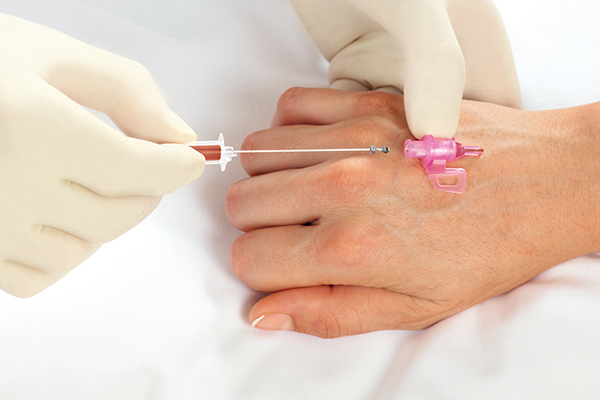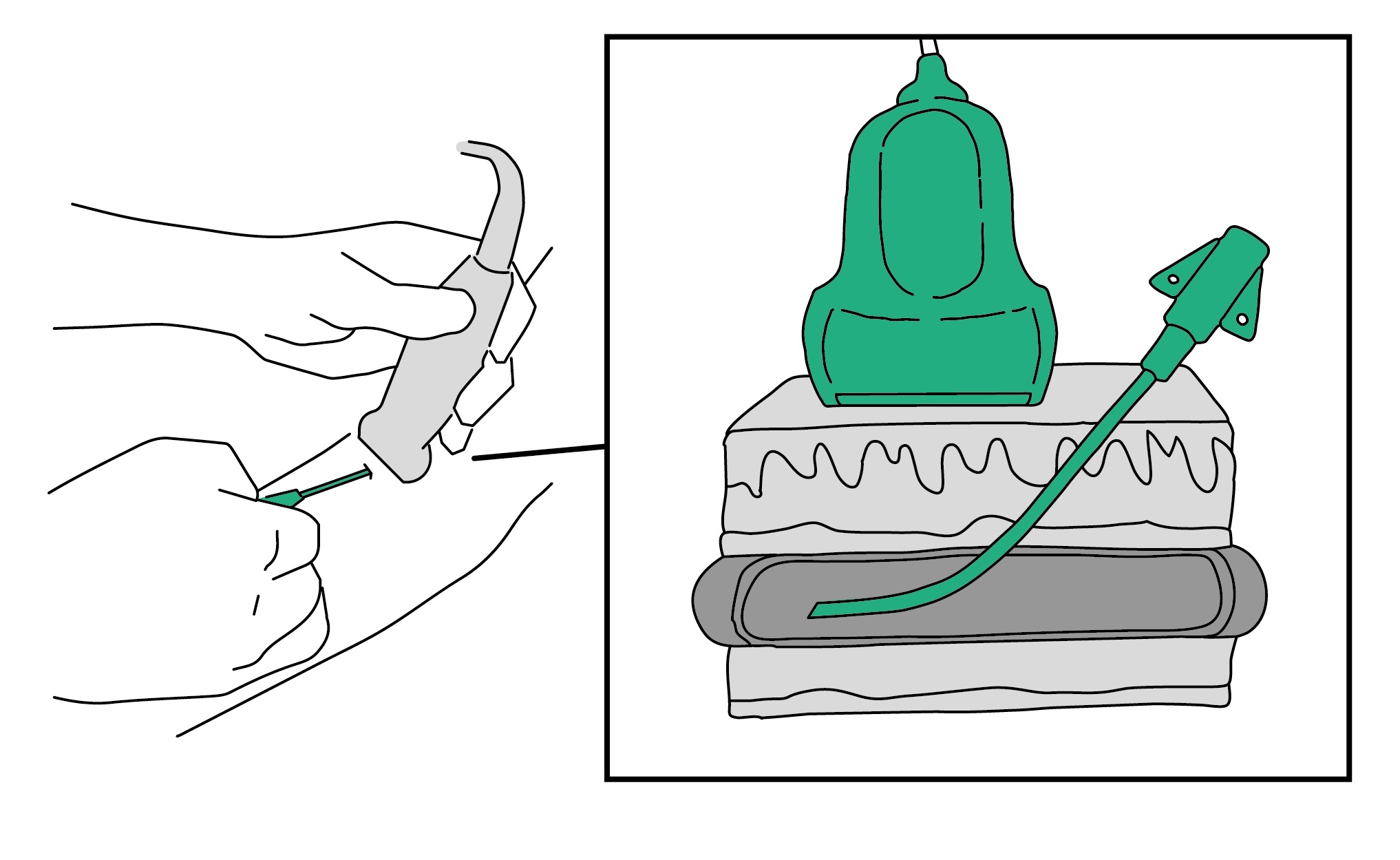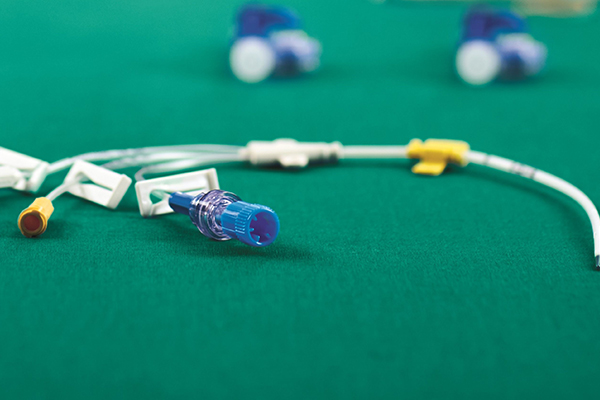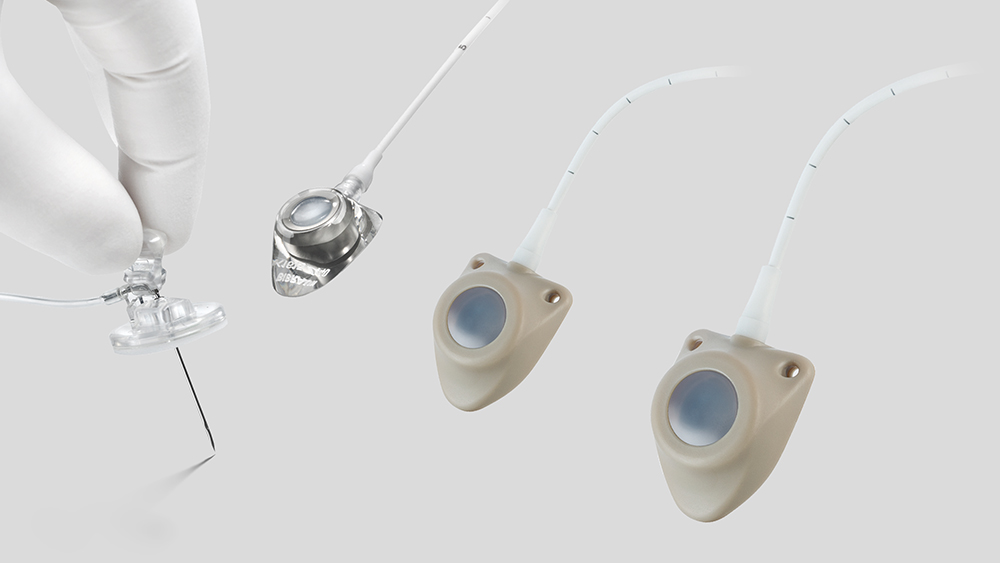Sei uscito con successo.
Not registered yet?
Accesso endovenoso difficile
La sfida quotidiana per il personale ospedaliero
La definizione di un accesso intravenoso periferico funzionale è una routine sia in situazioni di emergenza che in ambiente ospedaliero. Sebbene il metodo tradizionale di palpazione venosa per l'incannulazione abbia successo nella maggior parte dei pazienti, i pazienti con accesso endovenoso difficile rappresentano una sfida quotidiana per il personale ospedaliero.1

On this page
Sei un operatore sanitario?
Cliccando 'Confirm" dichiari di essere un operatore sanitario.
Se sei un paziente o un giornalista visita le pagine a te dedicate.
Conferma Sì, sono un operatore sanitario. Cancella No, non sono un operatore sanitario.L'accesso endovenoso difficoltoso può essere previsto nei seguenti pazienti. 2,3
Pazienti in emergenza
Pazienti in emergenza
Pazienti acuti, ad es. ustioni cutanee, ematomi o disidratazione
Sapevi che... ?
L'accesso endovenoso difficoltoso (DIVA) si intende generalmente quando due o più punture vengono eseguite senza successo, quando sono richiesti metodi di supporto alla puntura o quando l'impossibilità di ottenere l'accesso periferico implica che è necessario inserire un catetere venoso centrale (CVC). 2,3,4
L'accesso endovenoso difficile non è raro
Infatti, oltre il 30% degli adulti e fino al 50% dei bambini che necessitano di una PIVC sono dichiarati con accesso venoso difficile.2
Le complicanze associate al catetere complicano ulteriormente la situazione. Fino al 90% dei cateteri endovenosi periferici corti fallisce prima del completamento della terapia.6
50% di fallimento entro 24 ore.7
Cause
Il gruppo di potenziali pazienti DIVA è ampio:
Pazienti pediatrici, pazienti sovrappeso e obesi, pazienti anziani e affetti da patologie croniche e pazienti acuti. Cercano tutte vene profonde. 2,3
Pazienti pediatrici
Nei pazienti pediatrici, il tasso di successo del primo stick è inferiore al 35% a causa degli strati di tessuto più spessi.8


Pazienti in sovrappeso/obesità
Nei pazienti sovrappeso e obesi, sono solitamente necessari più tentativi a causa dello strato di tessuto adiposo sottocutaneo più spesso, che a sua volta è associato a due rischi. 8,9 Possono aumentare sia il tasso di errore di puntura che di infiltrazione. Secondo l'OMS, l'obesità è quasi triplicata in tutto il mondo dal 1975 e si prevede un ulteriore aumento in Europa. 10,11
Pazienti geriatrici/malattie croniche
I pazienti anziani e affetti da patologie croniche, come quelli affetti da diabete, presentano sistemi vascolari più deboli. Negli Stati Uniti, il 14,5% delle persone ha più di 65 anni e 422 milioni soffrono di diabete.13


Pazienti in emergenza/acuti
Le lesioni, come ustioni cutanee, ematomi o disidratazione, provocano un accesso intravenoso difficile in circa l'11% dei pazienti in pronto soccorso o in terapia intensiva.14
Conseguenze
L'accesso endovenoso difficile è di solito associato a ripetuti tentativi di inserimento e complicazioni associate al catetere. Questi non solo richiedono tempo o consumo di altri dispositivi, ma determinano anche un aumento del livello di stress tra il personale infermieristico e il paziente, unito a una maggiore percezione del dolore.9
Tentativi di inserimento ripetuti
In particolare nel pronto soccorso, è stato riscontrato che il problema dei tentativi di inserimento multipli nei pazienti DIVA ha un impatto negativo sia sulla sicurezza che sulla soddisfazione del paziente. Ad esempio, diversi tentativi falliti di inserimento dell'accesso vascolare spesso provocano un aumento dell'agitazione dei pazienti, con conseguente "fobia dell'ago" e perdita di fiducia nei professionisti sanitari. I pazienti possono sviluppare dolore o ecchimosi nei siti di inserimento, esponendoli a un rischio più elevato di lesioni cutanee e infezioni. Un accesso ritardato può aumentare ulteriormente il tempo necessario per le diagnosi o i trattamenti necessari, per la rianimazione con liquidi e la somministrazione di farmaci o antidolorifici.2 Inoltre, possono essere associate a un progressivo deterioramento del patrimonio vascolare, denominato "esaurimento vascolare", che complica ulteriormente l'accesso vascolare durante i successivi contatti con il paziente.15

Complicanze associate al catetere
Una volta incannulato, la sopravvivenza dei cateteri intravenosi è problematica.
-
Circa il
0%
dei PIVC si interrompono precocemente a causa di complicanze quali spostamento, infiltrazione o stravaso.6
Potenziali complicanze
Quando si verifica uno spostamento il catetere perde l'accesso al vaso del paziente e provoca un'interruzione forzata e prematura della terapia infusionale. L'infiltrazione o lo stravaso, invece, si verificano quando la punta dell'ago non si posiziona correttamente nel vaso e la soluzione infusa fluisce nel tessuto circostante l'accesso vascolare. Questa complicanza è particolarmente importante quando si infondono sostanze altamente irritanti (ad es. vescicole).6

Oltre allo stress e al tempo, i tentativi ripetuti di inserimento costano soprattutto materiale. Ad esempio, il costo medio di sostituzione del PIVC per terapia endovenosa è di 51,92 dollari.17 L'inserimento ripetuto fallito di un PIVC talvolta porta al passaggio a soluzioni più costose e complesse e all'uso di cateteri venosi centrali (CVC) o cateteri centrali inseriti perifericamente (PICC).
Entrambe le alternative richiedono un processo di inserimento più lungo e sono associate a costi del materiale più elevati. Tuttavia, in molti casi, i CVC vengono inseriti inutilmente. Sebbene i pazienti siano idonei all'uso di un catetere endovenoso periferico, si utilizzano CVC o PICC a causa di un accesso intravenoso difficile e non secondo i tempi di permanenza o soluzione di infusione.18
L'accesso endovenoso difficile può raggiungere
-
0min
per inserimento3
Il tempo medio richiesto per l'incannulazione endovenosa periferica è di 2,5-13 minuti.
"I pazienti con accesso intravenoso difficile sono spesso sottoposti a ripetuti tentativi da parte di più medici. La percentuale di successo e il tempo di incannulazione vascolare sono fondamentali per la rianimazione ottimale di un paziente gravemente malato. Questo può essere difficile anche per l'infermiere di emergenza più esperto."3
Strategie preventive
Per trattare i pazienti con DIVA in modo da non sprecare tempo e materiale, si consiglia l'uso di PIVC più lunghi e l'inserimento del catetere attraverso l'utilizzo di ultrasuoni.
Le cannule lunghe PIVC aumentano il tempo di sopravvivenza del catetere. Una parte più lunga del capillare rimane nella vena e aiuta a prevenire lo spostamento e le infiltrazioni del catetere. 16,18,20,21,22
Secondo Bahl et al. 2019, la lunghezza ottimale del catetere in vena è di almeno 2,75 cm.
Inoltre, la puntura venosa guidata da ultrasuoni favorisce il successo al primo tentativo. 22,23,24
La cannula lunga nei pazienti DIVA
-
Tempo di permanenza medio
0
giorni16
-
Tasso di successo al primo tentativo
0%
Sotto guida ecografica19
-
Termine della terapia
0%
Libera da complicanze per la durata necessaria della terapia19
"È necessario selezionare un PIVC di dimensioni adeguate (misura e lunghezza) a seconda delle vene del paziente: il diametro è importante per i pazienti con vene molto sottili, mentre la lunghezza è importante per i pazienti obesi con vene in posizione profonda."5

"È stato osservato che i PIVC più lunghi hanno una minore incidenza di infiltrazione e stravaso, il che è particolarmente importante quando si infondono sostanze altamente irritanti (ad es. vescicante)".12
"La procedura guidata con ultrasuoni e catetere lungo è associata a un minor rischio di rottura del catetere rispetto alla procedura guidata con ultrasuoni e catetere corto."20
[1] Bahl A, Hang B, Brackney A, Joseph S, Karabon P, Mohammad A, ... & Shotkin P. Standard long IV catheters versus extended dwell catheters: A randomized comparison of ultrasound-guided catheter survival. The American journal of emergency medicine. 2019;37(4);715-721.
[2]Whalen M, Maliszewski B, Baptiste DL. Establishing a Dedicated Difficult
Vascular Access Team in the Emergency Department: A Needs Assessment. J InfusNurs. 2017 May/Jun;40(3):149-154.
[3] Crowley M, Brim C, Proehl J, Barnason S, Leviner S, Lindauer C, Naccarato M,Storer A, Williams J, Papa A. Emergency nursing resource: difficult intravenous access. Journal of emergency nursing. 2012 Jul 1;38(4):335-43.
[4] Rodríguez-Calero MA, Blanco-Mavillard I, Morales-Asencio JM, FernándezFernández I, Castro-Sánchez E, de Pedro-Gómez JE. Defining risk factors associated with difficult peripheral venous Cannulation: A systematic review and meta-analysis. Heart & Lung. 2020 May 1;49(3):273-86.
[5] Bertoglio S, van Boxtel T, Goossens GA, Dougherty L, Furtwangler R, Lennan E, Pittiruti M, Sjovall K, Stas M. Improving outcomes of short peripheral vascular access in oncology and chemotherapy administration. The Journal of Vascular Access. 2017 Mar;18(2):89-96.
[6] Helm RE, Klausner JD, Klemperer JD, Flint LM, Huang E. Accepted but unacceptable: peripheral IV catheter failure. Journal of Infusion Nursing. 2015 May 1;38(3):189-203
[7] Steere L, Ficara C, Davis M, Moureau N. Reaching one peripheral intravenous catheter (PIVC) per patient visit with lean multimodal strategy: the PIV5Rights™ bundle. Journal of the Association for Vascular Access. 2019;24(3):31-43.
[8] Nafiu OO, Burke C, Cowan A, Tutuo N, Maclean S, Tremper KK. Comparing peripheral venous access between obese and normal weight children. Paediatr Anaesth. 2010 Feb;20(2):172-6
[9] Fields JM, Piela NE, Ku BS. Association between multiple IV attempts and perceived pain levels in the emergency department. J Vasc Access. 2014;15:514–8
[10] WHO Obesity and overweight https://www.who.int/news-room/fact sheets/detail/obesity-and-overweight
[11] Pineda E, Sanchez-Romero LM, Brown M, Jaccard A, Jewell J, Galea G, Webber L, Breda J. Forecasting Future Trends in Obesity across Europe: The Value of Improving Surveillance. Obes Facts. 2018;11(5):360-71.
[12] (Department of Health AU, PIVC Guideline) https://www.health.qld.goc.au/_data/assets/pdf_file/0025/444490/icare-pivc-guideline-pdf
[13] Wengström Y, Margulies A; European Oncology Nursing Society Task Force. European Oncology Nursing Society extravasation guidelines. Eur J Oncol Nurs. 2008 Sep;12(4):357-61
[14] Dychter Samuel S. MD, Gold David A PhD, Carson Deborah RN, Haller, Michael PhD. Intravenous Therapy: A Review of Complications and Economic Considerations of Peripheral Access. Journal of Infusion Nursing. 2012 Mar;35(2);84-91.
[15] Moraza-Dulanto MI, Garate-Echenique L, Miranda-Serrano E, ArmenterosYeguas V, Tomás-López MA, Benítez-Delgado B. Inserción eco-guiada de catéteres centrales de inserción periférica (PICC) en pacientes oncológicos y hematológicos: éxito en la inserción, supervivencia y complicaciones. Enferm Clin. 2012;22(3);135–143
[16] Bahl, A., Hijazi, M., Chen, N.W., Clavette-Lachapelle, L. and Price, J., 2019. Ultra Long versus Standard Long Peripheral Intravenous Catheters: A Randomized Controlled Trial of Ultrasound-Guided Catheter Survival. Available at SSRN 3401988
[17] Marsh N, Webster J, Larson E, Cooke M, Mihala G, Rickard CM. Observational Study of Peripheral Intravenous Catheter Outcomes in Adult Hospitalized Patients: A Multivariable Analysis of Peripheral Intravenous Catheter Failure. J Hosp Med. 2018 Feb 1;13(2):83-89
[18] Paladini A, Chiaretti A, Sellasie KW, Pittiruti M, Vento G. Ultrasound-guided placement of long peripheral cannulas in children over the age of 10 years admitted to the emergency department: a pilot study. BMJ Paediatr Open. 2018 Mar 28;2(1):e000244
[19] Godfrey J, Gallipoli L. Introducing a long peripheral catheter to support improved outcomes for difficult access (DIVA) patients. 2022 Oct. World Congress of Vascular Access.
[20] Elia, F., Ferrari, G., Molino, P., Converso, M., De Filippi, G., Milan, A. and Aprà, F., 2012. Standard-length catheters vs long catheters in ultrasound-guided peripheral vein cannulation. The American journal of emergency medicine, 30(5), pp.712-716.
[21] Meyer P, Cronier P, Rousseau H, Vicaut E, Choukroun G, Chergui K, Chevrel G, Maury E. Difficult peripheral venous access: clinical evaluation of a catheter inserted with the Seldinger method under ultrasound guidance. Journal of critical care. 2014 Oct 1;29(5):823-7.
[22] Scoppettuolo G, Pittiruti M, Pitoni S, Dolcetti L, Emoli A, Mitidieri A, Migliorini I, Annetta MG. Ultrasound-guided “short” midline catheters for difficult venous access in the emergency department: a retrospective analysis. International journal of emergency medicine. 2016 Dec;9(1):1-7.
[23] Vinograd, A.M., Chen, A.E., Woodford, A.L., Fesnak, S., Gaines, S., Elci, O.U. and Zorc, J.J., 2019. Ultrasonographic Guidance to Improve First-Attempt Success in Children With Predicted Difficult Intravenous Access in the Emergency Department: A Randomized Controlled Trial. Annals of emergency medicine.
[24] Stolz LA, Stolz U, Howe C, Farrell IJ, Adhikari S. Ultrasound-guided peripheral venous access: a meta-analysis and systematic review. The journal of vascular access. 2015 Jul;16(4):321-6.
Restate connessi con My B. Braun
Con il tuo account personalizzato, la tua esperienza online sarà più facile, più comoda e più sicura.




